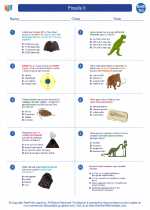Resonance in Earth Science
Resonance is a phenomenon that occurs when an object or system is subjected to vibrations at its natural frequency, causing it to oscillate with greater amplitude. In Earth Science, resonance plays a significant role in several natural processes, including seismic waves, ocean tides, and atmospheric oscillations.
Key Concepts
1. Natural Frequency: The frequency at which an object or system tends to vibrate with the greatest amplitude. For example, an earthquake generates seismic waves that can cause buildings and other structures to resonate at their natural frequencies.
2. Resonant Frequency: The specific frequency at which resonance occurs, leading to increased amplitude of oscillation. In the context of Earth Science, this can be observed in the resonance of ocean tides or the oscillations of the Earth's atmosphere.
3. Seismic Resonance: Earthquakes can cause buildings and other structures to resonate at their natural frequencies, leading to increased damage and destruction.
4. Ocean Tide Resonance: The gravitational forces of the Moon and Sun can cause ocean tides to resonate in bays and estuaries, amplifying the tidal range and leading to phenomena such as tidal bores.
5. Atmospheric Resonance: Atmospheric oscillations, such as the Madden-Julian Oscillation (MJO) and the El Niño-Southern Oscillation (ENSO), can exhibit resonance, influencing weather patterns and climate variability.
Study Guide
When studying resonance in Earth Science, consider the following key points:
- Identify the natural and resonant frequencies of various Earth systems, such as seismic waves, ocean tides, and atmospheric oscillations.
- Understand the impact of resonance on infrastructure and natural environments, particularly in the context of earthquakes and ocean tides.
- Explore real-world examples of resonance in Earth Science, such as the resonance of buildings during earthquakes, the amplification of tides in estuaries, and the influence of atmospheric resonance on global weather patterns.
- Consider the role of resonance in natural hazard mitigation and climate modeling, and how an understanding of resonance can inform engineering practices and environmental management.
- Examine the interconnectedness of different Earth systems and how resonance can lead to complex interactions and feedback mechanisms.
By grasping the concept of resonance in Earth Science, students can gain insights into the dynamic and interconnected nature of Earth's processes and phenomena.
.


